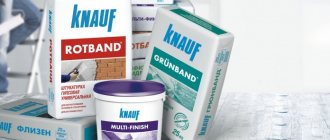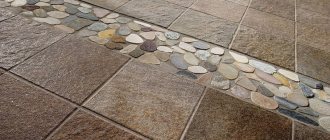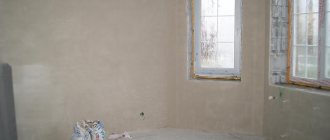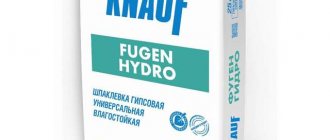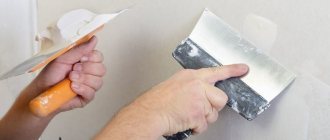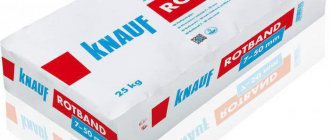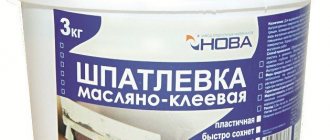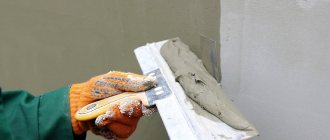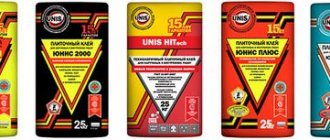Finishing work, including preparing surfaces and even giving their relief unusual shapes, cannot do without putty. The market is rich in choice, but many consumers are attracted to Knauf putty. The company offers a wide range of putty materials from powder mixtures to ready-made emulsions. Let's look at the most popular varieties. It is worth noting that all putty mixtures from this manufacturer contain adhesive ingredients.
Briefly about the product
Putty is a composition containing substances that form a film, filling irregularities, crevices and cracks. Used as a preparatory stage for interior and facade work. They come in the form of dry mixtures and ready-to-use without mixing the solution. This affects the price and shelf life. Ready ones can be frozen if the entire package is not used immediately.
The entire product line is divided according to two criteria:
- compound;
- appointment.
Based on their composition, there are gypsum, cement and polymer mixtures, each of which has its own characteristics. Thus, the gypsum composition is the cheapest, but is not “friendly” with water - it is used only in those rooms where there is not and will not be a humid environment. Cement ones are several orders of magnitude stronger, but they shrink significantly. Polymer ones perform best, but they are also more expensive.
According to their intended purpose, the market offers: basic (starting), finishing (decorative) and universal. According to the name, the first is applied to plastered walls as a preparation, the second creates a perfectly flat, smooth surface, and the third, universal, can be used to seal large flaws on any surface.
Basic
The functions that this type performs are included in the name - processing, leveling surfaces at the initial stage to seal large holes. Apply in a thick layer of at least 2 cm. It should have good adhesion to the wall. Mandatory stage.
Knauf-Rotband Finish
Designed for plasterboard, tongue-and-groove and gypsum sheets. For interior work on top of gypsum and cement plasters. It is economically used and does not generate dust. After kneading, the working ability is maintained for 1.5 hours.
Knauf Rotband Finish
General characteristics:
| Consumption, kg/sq.m | 1 |
| Layer thickness, cm | 0,02-0,5 |
| Packing | Paper bag, dry mix, 25 kg |
| Fraction size (grain) | 0,15 |
| Shelf life | 6 months In a closed package |
Cost 364 rub.
Knauf-Fugen GV
Former name Fügen Fühler. The mixture is intended for interior use. Consists of gypsum, binders and polymer impurities. Almost all of its products are for complex use, and therefore recommends using it with gypsum fiber sheets, more precisely for filling joints and cracks.
Knauf-Fugen GV
But builders use it in other ways:
- puttying concrete and plastered surfaces with a thin layer;
- gluing plasterboard sheets to walls with a difference of up to 4 mm;
- attaching protective metal corners;
- working with gypsum elements.
It may have white, gray and pink undertones, depending on the natural impurities of the gypsum. Color has no effect on quality. The solution is mixed in a ratio of 1:0.8, in particular, 0.8 liters of cold water per 1 kg (water temperature up to 30°C), after which you need to leave the solution for 3 minutes. If you do not adhere to the temperature regime, it may crack. The addition of other substances also affects the quality. The working properties are maintained for 30 minutes before thickening begins, after which water will not bring it back to life. It is recommended to work in small portions.
General characteristics:
| Consumption | GVL joints: 0.3 – 0.6 kg per m2 with continuous puttying with a layer of 1 mm: 0.8 kg/m2 |
| Layer thickness, cm | 0,02-0,5 |
| Packing | Paper bag, dry mix, 25 and 10 kg |
| Fraction size (grain) | no more than 0.2 mm |
| Shelf life | 6 months In a closed package |
Price for 10 kg – from 200 rubles; 25kg – from 390 rub.
Knauf Multi-Finish "White"/"Grey"
Multifinish contains white and gray cement (depending on the name) and polymer admixtures. This putty is used for exterior work, decoration of facades and interior decoration of walls and ceilings. Levels concrete, cement plaster. A high-strength layer of 1-5 mm dries up to three days if the air temperature is +10°C, more than 20°C - 24 hours. The wall must be dry and clean. Mix at the rate of 0.3 liters of water per 1 kg of powder. Can be adjusted depending on the result. Plasticity is maintained for 3 hours. Not susceptible to thermal changes. If there is a risk of cracks appearing on the wall, it is necessary to use reinforced mesh. Do not sand or rub until completely dry.
Multi Finish
General characteristics:
| Consumption | continuous layer 1 mm 1.2 kg/m2 |
| Frost resistance | 25 cycles |
| Packing | Paper bag, dry mix, 25 kg |
| Shelf life | 6 months in closed packaging |
| Shelf life of the finished solution | 3 hours |
Price from 430 rub.
Knauf-Uniflot
It is recommended to mix by hand in small quantities (add water to the thick consistency as you go). In the proportion of 0.5 liters of water per kilo of powder. Used indoors for finishing slabs with perforations, seam joints, and “Superfloor” systems. The mixture is dry, based on gypsum binder with polymer additives, and does not crack. The manufacturer does not recommend thinning the hardened layer to avoid cracking of the surface.
Uniflot
Specifications:
| Consumption | continuous layer 1 mm: 0.4 kg/m2 |
| Layer thickness, cm | 0,1-0,5 |
| Packing | Paper bag, dry mix, 5 and 25 kg |
| Fraction size (grain) | no more than 0.15 mm |
| Shelf life | 6 months in closed packaging |
Price for 5 kg packaging – 365 rubles; 25 kg – 1500 rub.
Acrylic putty: disadvantages and advantages over gypsum putty
Every year we see more and more different new products on the building materials market. This also applies to putties.
Putty is a special paste for leveling, pre-processing and preparing various surfaces. The putty is applied to the surface using a special spatula.
After complete drying, the material hardens, and all excess is sanded off with sandpaper.
Before buying putty, you should know that they are divided into several types according to their functionality, composition and degree of readiness for use.
All putty is divided into several types, it depends on its main astringent ingredients.
Gypsum putty - this putty is made on the basis of gypsum components. Gypsum putty is easy to level and does not shrink. But you should know that gypsum putty has its drawbacks: poor moisture resistance, so it is used only in a limited area.
Acrylic putty consists of a film-forming substance and filler, crushed marble. Acrylic putty is used to level the surface for interior and exterior decoration. Advantages acrylic putty is intended for almost all types of surfaces, wood, concrete, brick.
The next type is polymer putty. This putty is considered the highest quality for puttying, but you must take into account that it costs an order of magnitude higher. It has also been established that such putty is most often counterfeited.
There is another type of putty - cement. Advantages: good moisture resistance and reasonable price. Disadvantages: prone to shrinkage.
Putty is also divided into types according to the degree of readiness for use, these are ready-made putty and dry.
Ready-made putty is convenient because it has a long shelf life. But this is not its only advantage.
Ready-made putty is very convenient to use, since you do not need to waste time preparing the paste, and you also do not need to rack your brains over the preparation technology.
The paste components are sold already diluted in the required proportions, ready for use.
But the finished putty not only has advantages, it also has some disadvantages; such putty cannot be used in thin layers, as it is prone to shrinkage. In addition, ready-made putty has a high cost.
It is recommended to prepare dry putty immediately before use. This is a special mixture that contains the necessary substances in the required proportions. This putty is packaged in bags in dry form. Advantages reasonable price, good quality material, but subject to proper use.
Preparing the pasta is not at all difficult; for this purpose, there are instructions on the package that must be followed. Otherwise, you will not get the expected result. This putty is also convenient in that it is intended for any type of work, even the most delicate.
Disadvantages: The service life of the already prepared mixture is relatively short.
What is the difference between gypsum putty and acrylic putty?
The main difference between gypsum putty and acrylic putty is that gypsum putty is not able to withstand moisture. For this reason, it cannot be used, for example, in a bathroom where the humidity level is quite high. In such rooms it will peel off in pieces and crumble. Therefore, it should only be used in dry rooms.
Acrylic putty, on the contrary, has high moisture resistance and elasticity. It is used for finishing walls when leveling, and it must be applied in a very thin layer, literally 1 mm. The surface of the walls or ceiling is thus perfectly smooth and even.
Gypsum putty can be applied in a thicker layer, but the wall will look much rougher.
Another difference between these putties is that the acrylic one is sold ready-made, while the gypsum one must be diluted independently.
The choice should still be made on acrylic putty, since it has a wider range of applications. and the quality of the surface finished with it is higher.
the system chose this answer as the best
Polymer putties: acrylic and latex
During the puttying process, different types of putties can be used. In the previous article we have already examined the main characteristics of gypsum and cement putties, now we will consider for which surfaces polymer ones are best suited.
Such material is produced and sold in ready-made form, i.e. You won’t have to mix or dilute anything anymore. This is a huge plus, since it will no longer be possible to spoil the mixture, making it less stable, for example. But, unfortunately, this advantage can be negated if the putty is stored incorrectly, then it can lose all of its beneficial properties.
It’s worth noting right away that there is also diversity among polymer putties. So, they are divided into acrylic and latex. But first things first.
Acrylics use a polymer substance such as acrylic as a base. It is a completely artificial material, so its properties are easy to change.
Positive characteristics include the fact that acrylic easily interacts with all other components of the putty, forming a uniform surface structure, and this, in turn, negates the likelihood of cracks appearing after drying.
This material is quite versatile in its scope: it can be used both on internal and external walls. In addition, it is easily applied to any type of surface, retaining all its qualities equally well.
It can be wood or concrete, plastic or drywall, etc. And applying the finished mixture is a pleasure, because acrylic is already quite plastic, and with the addition of plasticizers it becomes very easy to use.
Acrylic putty can also be divided into finishing and starting, but here the classification depends not on the size of the particles, but on what additives were used.
The main disadvantage of this material is its relatively high cost compared to other types of putties, but if you take into account the cost-effectiveness of use and ease of use, as well as versatility and durability, the price becomes completely justified.
If latex is used as a polymer base, then the putty is called latex .
Since it is essentially rubber, the finished surfaces are more resistant than acrylic ones, and the material itself is more elastic.
This type of putty is even more versatile, because it can be used on all surfaces without exception, even metal. It does not shrink and can be used at almost any temperature.
But such material costs quite a lot and is recommended for use mainly on external walls, since it has low vapor permeability and practically does not “breathe”.
Thus, polymer putties can be called the most universal. Moreover, they usually contain antiseptics, which prevents the appearance of mold and mildew.
Universal acrylic waterproof putty VGT. Practice, application experience, reviews. putty
Application practice, pros and cons, advantages and disadvantages of the universal acrylic putty VGT. Methods of use.
The most important:
Really good putty at a reasonable price. After drying, it is quite durable, easy to apply, paint, and sand.
This putty can be applied in a very thin layer. The thicker layer does not crack. You can putty in two steps. First roughly, then dry, then cover the cracks and level with a thin layer.
If stored incorrectly, the putty may dry out. But, if it is not completely dry yet, then you can add a little water to it and stir.
Strengths of the universal acrylic putty VGT
It quickly comes to a tack-free finish and is ready to be sanded.
After drying, it is waterproof, does not dissolve with water, is not washed away by water-dispersed paints, and does not absorb water. The putty surface can be painted with almost any paints and enamels, both acrylic and latex, alkyd, nitro, etc. without additional priming.
Can be applied in a very thin layer, less than a millimeter. In general, it is very convenient to apply, spread like good country butter on bread.
Virtually odorless and non-toxic.
Diluted, if necessary, with water. I also wash the tool with water until the putty hardens. If it has frozen, we clean it off mechanically.
After sanding, a smooth, even surface is formed.
Can be used to putty construction bandages.
Can fill deep cracks and cavities. Gives little shrinkage when drying.
Has sufficient strength. Temporarily filled a small pothole in the floor 3 years ago. Didn't reinforce it with anything. I still go.
It applies well as a second layer, on already puttied and sanded surfaces without intermediate priming. This is generally a rare property. In my experience, many putties apply very poorly as a second coat on sanded surfaces. For normal adhesion, intermediate priming is required, otherwise the second layer will fall off.
Works well on wood, sanded chipboard, and almost any alkyd and acrylic primers.
Great price.
Disadvantages and problems of VGT putty
Although the manufacturer claims that the putty can be used to fill cavities up to 7mm without cracking, this is not actually the case. The putty, of course, cracks and shrinks in such cavities. Puttying has to be done in two stages. First roughly, and then fill the small cracks and cavities that have arisen.
Sanding produces very fine and caustic dust. Work only in a respirator and goggles, ventilate the room.
It is quite difficult to sand and quickly clogs the skin. Fine dust and rapid wear of the skin are the other side of the coin - fine filler, which allows you to apply the putty in a very thin layer. So you have to put up with it.
Application of VGT putty
I use universal acrylic putty VGT everywhere: for leveling walls and ceilings, repairing and finishing wooden products and chipboard parts, filling cavities and cracks, filling construction tape, edging chipboard, filling recesses under screw heads.
Final grade - bold plus
You may be interested in the article: Painter's tutorial.
Types of putties for walls
The reliability and quality of subsequent repairs largely depends on how correct the choice of putty for wall finishing is. Putty is an irreplaceable material, the presence of which is mandatory during the finishing process. Types of putty for walls are primarily divided into ready-to-use and “dry”.
Then they are crushed according to the type of binder component: polymer, cement, gypsum. Finally, the putties are divided according to their intended purpose.
Ready-made putties
They are produced on the basis of dispersions or latexes and represent a mass diluted in ideal proportions.
Sold in tanks or buckets.
Advantages of ready-made putty:
- can be used immediately for work;
- the finished solution can be used for an unlimited time.
Dry putties
The most common option when leveling walls. Sold in bags or bags.
Advantages of dry putty:
- ease of preparation;
- convenient to store and transport;
- low cost;
- the ability to control the degree of viscosity of the mixture;
- storage duration regardless of temperature.
Flaws:
- the need to prepare the solution strictly according to technology using additional equipment;
- the finished composition requires quick implementation.
Depending on what binder is the basis, types of wall putties can be polymer, gypsum and cement.
Polymer putties
Advantage of polymer putty:
- highest quality putty.
Flaws:
- there is a risk of purchasing defective products;
- high price.
Gypsum putties
Advantages of gypsum putty:
- no shrinkage, making it possible to level a layer more than two 2 mm thick.
Flaw:
- It is prohibited to work in rooms with sudden changes in humidity and temperature; therefore, it cannot be used for facade finishing.
Cement putties
Advantages of cement putty:
- water resistance;
- suitable for finishing rooms with high humidity.
Flaws:
- possible formation of microcracks;
- low elasticity and long hardening;
- When dry, it shrinks and requires repeated filling.
When choosing putty, you should pay attention to the size of the filler particles: the smaller they are, the smoother and more even the putty surface will be.
There are four main groups of division of putties regarding their purpose:
- Leveling - used to level the surface. They have good adhesion to the base, uniformly filling all its defects, have high strength, and smooth out unevenness.
- Finishing – prepares the wall surface for decorative finishing.
- Specialized - designed for specific tasks.
- Universal - combine the properties of the first three types of putties and can be used on almost any substrate.
Before you buy putty, you should carefully read the instructions, which indicate its type, purpose, properties, composition and materials with which it is used.
Sources: rvm.su, www.remotvet.ru, moscowsad.ru, hw4.ru, vsyashpatlea.ru
Source: https://fotocam.net/texnologii/akrilovaya-shpaklevka-nedostatki-i-preimushhestva-pered-gipsovoj
Decorative putty Knauf
Finishing, used as a layer before decorative finishing (painting, wallpaper) or for exterior work. Sometimes, with the addition of color, crumbs, or as a layer before cladding on the facade of a building.
Knauf-HP Finish
Suitable for kitchens and bathrooms with average humidity levels. Designed for finishing ceilings and walls indoors. Dries quickly. The minimum thickness of the coating is 0.1 cm, max – 0.3 cm. It can take on shades of pink and gray, this is normal, this is how natural mixtures of gypsum minerals work.
HP Finish
Specifications:
| Consumption | continuous layer 1 mm: 0.9 kg/m2 |
| Layer thickness, cm | 0,1-0,5 |
| Packing | Paper bag, dry mix, 25 kg |
| Fraction size (grain) | no more than 0.2 mm |
| Shelf life | 6 months in closed packaging |
Price from 169 rub. per package.
Knauf-Rotband Pasta Profi
Ready-made putty in the form of a paste containing vinyl as a base. Final treatment of any indoor surfaces with a thin, snow-white application. Ready to use without using water. Easy and flexible to work with. It has a very smooth structure and “clings” to the wall. Doesn't "chalk". Not suitable for wooden surfaces.
Rotband Pasta
Specifications:
| Consumption | For a continuous layer of 0.5 mm 0.5 kg/sq.m |
| Layer thickness, mm | 0-2 |
| Fraction size (grain) | no more than 25 microns |
| Complete drying time 1 mm | Day |
| Frost resistance | Minimum – no more than 5 cycles |
| Shelf life | 12 months in a sealed container |
Price on the Internet for a bag weighing 18 kg from 800 rubles.
Knauf-Satengips
Developed on the basis of gypsum. Prepares the surface for the final decorative stages (wallpaper, painting). Can be used on both concrete and plasterboard surfaces. Eco-friendly - without impurities. Does not leave chalky marks. Not suitable for outdoor use. Open mixture does not dry for up to 100 minutes. Before use, it is better to apply a primer and let it dry.
Satengips
Specifications:
| Consumption | For a continuous layer 1 kg/sq.m |
| Layer thickness, mm | 0-2 |
| Fraction size (grain) | no more than 25 microns |
| Complete drying time 1 mm | Day |
| Frost resistance | Minimum – no more than 5 cycles |
| Shelf life | 12 months in a sealed container |
The cost of a 25 kg package is 238 rubles.
Universal
This type is used in both cases. Since it combines the properties of decorative and basic, this can directly affect the quality.
Knauf-Polymer Finish
Polymer binder mixture with high adhesion. Plastic and resistant to cracking. Can be applied to coatings made of concrete, plasterboard, plaster, from floors up to 4 mm. Contains microfibers. Operable for 72 hours. You can paint or glue wallpaper after complete drying. It is used inside as a finishing thin layer, as well as a base putty. Easily removed with sandpaper. You need to work in a temperature range of 10-30°C. Putty for dry rooms.
Polymer Finish
Specifications:
| Consumption | For a continuous layer 1.2 kg/sq.m |
| Layer thickness, mm | 0-2 |
| Fraction size (grain) | no more than 25 microns |
| Complete drying time 1 mm | Day |
| Packing | Paper bag 20 kg |
| Shelf life | 12 months in a sealed container |
Price 440 rub.
Knauf-Fugen Hydro
Unlike the previous one, Fugenfüller Hydro contains hydrophobic additives. For sealing seams and installing plasterboard and gypsum fiber sheets. The putty is intended for interior work in damp rooms and does not shrink. Layer thickness from 1 to 5 mm. Mix in a proportion of 1.3 liters per 1 kg of mixture.
Fugen Hydro
General characteristics:
| Consumption | GVL joints: 0.25 kg per m2 with continuous puttying with a layer of 1 mm: 0.8 kg/m2 |
| Layer thickness, cm | 0,02-0,5 |
| Packing | Paper bag, dry mix, 25 kg |
| Fraction size (grain) | no more than 0.2 mm |
| Shelf life | 6 months In a closed package |
Cost from 890 rub.
Knauf-Fugen
Sealing of joints of thin and semicircular-edged plasterboard sheets (GKL) occurs using reinforcing tape. Covers cracks, suitable for puttying both concrete and walls prepared with plaster. Can be used as an adhesive base for plasterboard panels. Designed for interior decoration with a layer of 0.1-0.5 cm.
Fugen
General characteristics:
| Consumption | per layer 0.1 mm 1m2 sealing joints, cracks - 250 g per m2 |
| Layer thickness, cm | 0,02-0,5 |
| Packing | Paper bag, dry mix, 5, 10, 25 kg |
| Fraction size (grain) | no more than 0.2 mm |
| Shelf life | 6 months In a closed package |
Price 113, 203 and 414 rubles, depending on volume.
Technical characteristics and consumption per 1 m2
Technical characteristics determine the quality of the coating, its drying time, and operating rules. According to the instructions, the putty has the following characteristics:
- Layer thickness – 0.2-2 millimeters;
- The average size of fractions in the composition is 25/50 microns;
- The temperature indicator for the solution is 10-30 degrees;
- Drying a millimeter layer lasts a day;
- Withstands up to five defrosting and freezing cycles.
One of the advantages of using putty mortar is low consumption. The average consumption rate is 1 kilogram per square meter of surface.
One of the advantages of using putty mortar is low consumption.
Recommendations for using Knauf putty
- Try to follow the instructions on the package.
- Do not add a lot of water at once; it is better to add it little by little than to immediately ruin the mixture or throw away the frozen block.
- Wait until completely dry before proceeding with further work.
- Store powder mixtures tightly closed in a paper bag and only in a dry, warm place.
- Do not try to re-thread cured putty as this may affect the smoothness.
- Do not add foreign substances or agents to the solution.
- Apply a reasonable coat of putty to complete the drying process and prevent chipping.
- Consider the purpose of the room when choosing materials.
- Look at the expiration date on the packaging and ask the seller for a certificate of conformity.
- If the material behaves strangely, most likely the storage technology was violated or you came across a fake.
VIDEO: How to recognize a fake Knauf Rotband
What is the difference between Shitrok and Volma finishing putties, which is better?
For working with putty, which plaster is better Rotband or Volma, the answer will be Rotband. There is a rule according to which it is always better to use products from one brand with each other, they take into account the features of the other.
But when it comes to the initial choice of putty solution, you need to compare brands. Shitrock, Volma, Rotband are popular products, so making a choice becomes more difficult.
If we talk about the Sheetrock product, then you can use the putty in rooms with a humid microclimate. For Rotband and Volma, this option is not applicable. These two compositions are intended for dry rooms.
All mixtures are distinguished by their high-quality properties, they practically do not shrink, do not become cracked, and make it possible to apply a thin layer of putty. If you follow the working technology, the result will last a long time. When choosing any composition, you must carefully study the purpose and conditions that the mixture can withstand.
But well-known brands can be counterfeited; for this reason, before purchasing, it is recommended to request a certificate of quality and conformity from the seller.
If we talk about the Sheetrock product, then you can use the putty in rooms with a humid microclimate.
